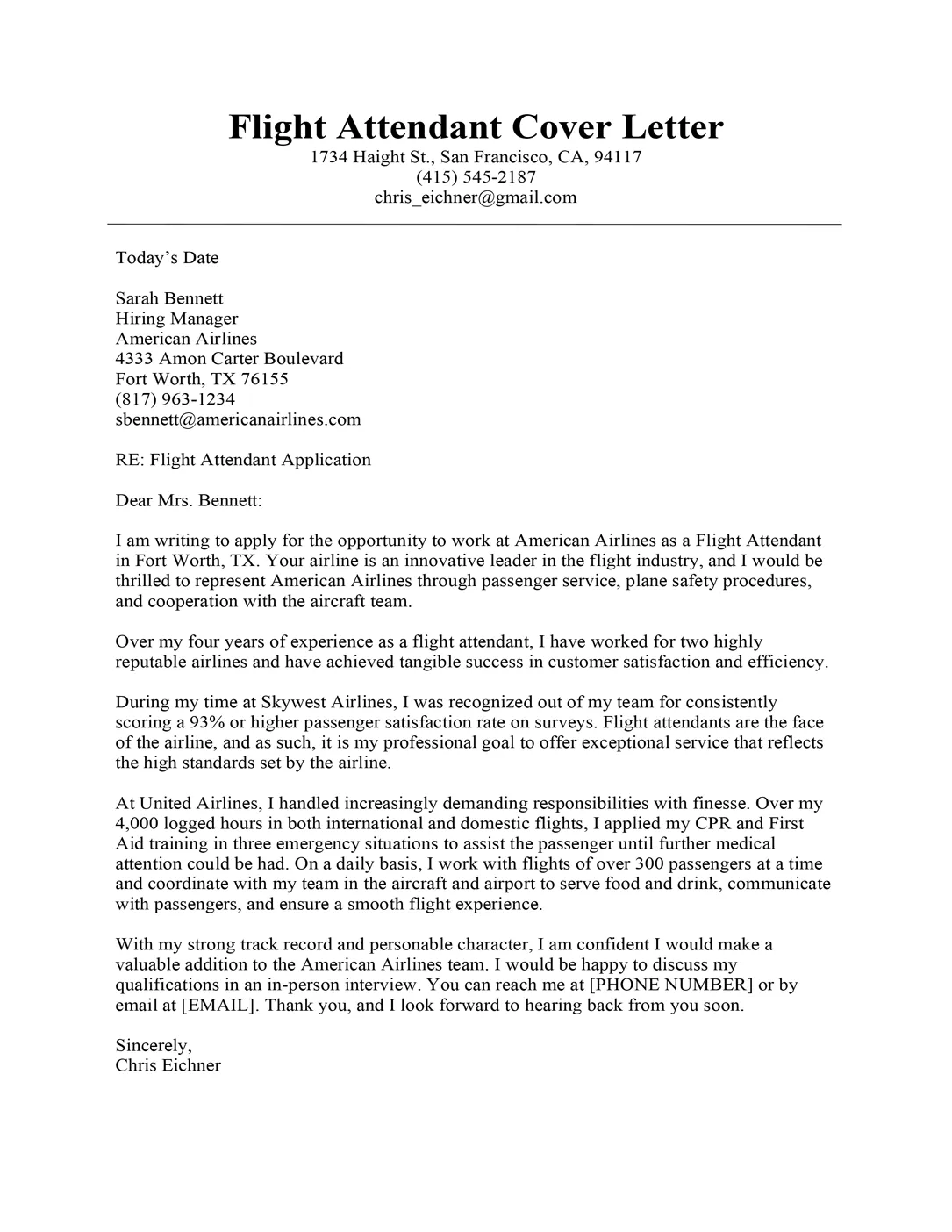Why You Need a Flight Attendant Cover Letter
A flight attendant cover letter is your first impression. It is your chance to showcase not just your qualifications, but also your personality and enthusiasm for the role. Unlike a resume, which lists your experiences, a cover letter allows you to tell a story – a story of why you’re the perfect candidate to join a cabin crew. It’s an opportunity to elaborate on the skills listed on your resume, providing specific examples and demonstrating how your experiences align with the airline’s needs and values. A well-crafted cover letter can significantly increase your chances of getting an interview and landing your dream job in the skies. Think of it as the opening scene of your aviation career, setting the stage for the exciting journey ahead. Neglecting this crucial step means potentially missing out on opportunities due to not highlighting your unique selling points and passion.
Understanding the Role of a Flight Attendant
Before you write a cover letter, understand what a flight attendant does. It’s far more than serving drinks and snacks. The primary responsibilities of a flight attendant are passenger safety and comfort. This involves ensuring compliance with safety regulations, assisting passengers during emergencies, and providing excellent customer service throughout the flight. You must be prepared to handle stressful situations, make quick decisions, and work effectively as part of a team. The role also includes handling various passenger needs, from helping with luggage to providing medical assistance if required. Demonstrating this understanding in your cover letter shows that you’ve researched the role and are ready for the challenges it presents. This will set you apart from candidates who may only have a superficial understanding of the job requirements.
Essential Sections for Your Cover Letter
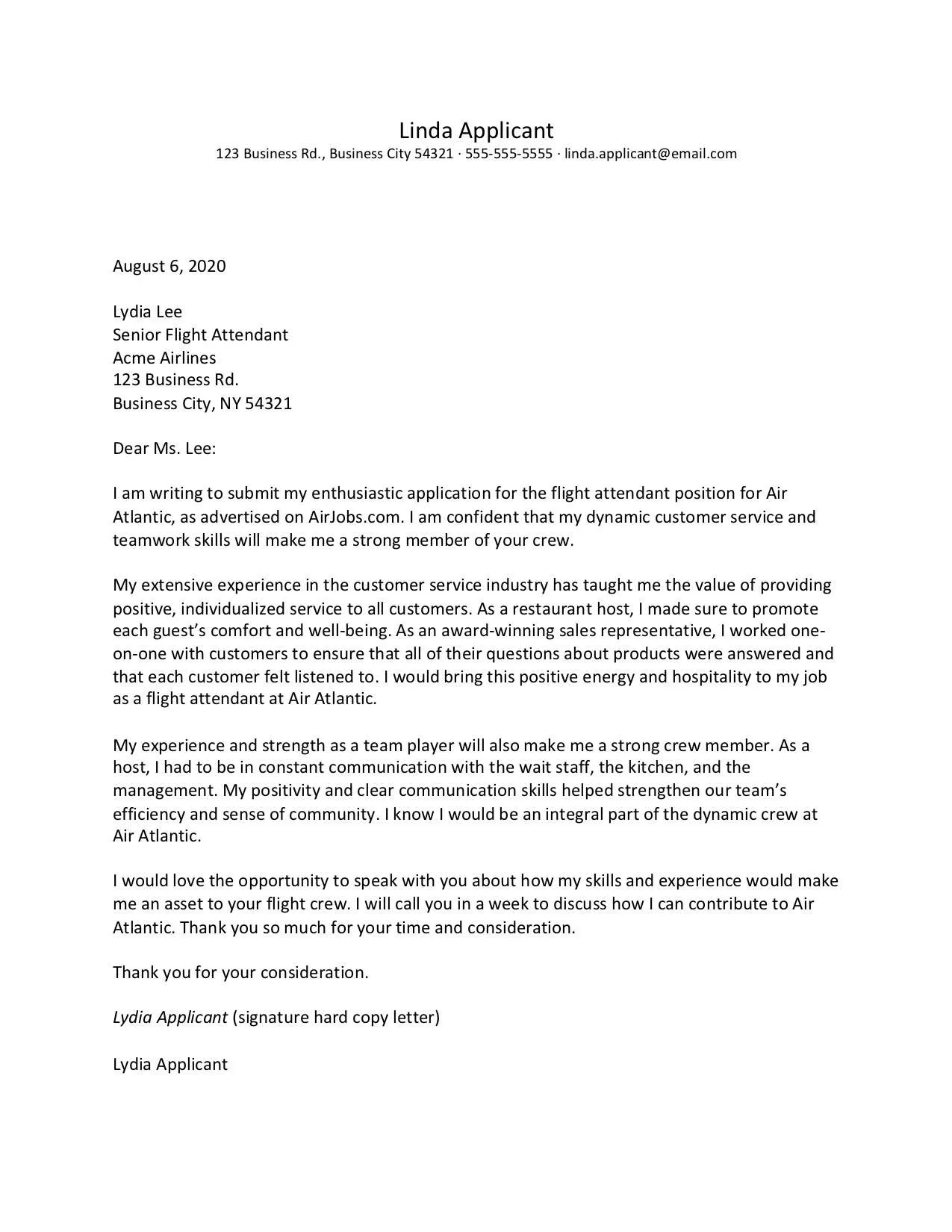
A well-structured cover letter is key to making a positive impression. The most critical sections include the header with your contact information, a personalized greeting, an engaging opening paragraph, a skills and experience section, a closing paragraph, and a call to action. The opening paragraph should grab the reader’s attention and state your purpose. The skills section should highlight relevant qualifications, supported by concrete examples. The closing paragraph should reaffirm your interest and express your availability for an interview. Remember, the goal is to provide a concise yet comprehensive overview of your suitability for the role, emphasizing what you can bring to the airline. Each section must complement the other to create a compelling narrative, proving your readiness and ability to excel as a flight attendant.
Header and Contact Information
Your header should clearly display your contact information. This includes your full name, phone number, email address, and optionally, your LinkedIn profile. This section ensures that the hiring manager can easily reach you. Make sure your email address is professional and your phone number is accurate. Double-check all details for accuracy, as even a small mistake can prevent you from being contacted. Using a clean, easy-to-read format enhances professionalism and ensures that your application leaves a positive, efficient impression. The header is more than just contact information; it’s a statement of your attention to detail and professionalism, which are essential qualities for a flight attendant. This is especially true, because it will be the first thing a potential employer will see, so the information provided must be accurate and easy to find.
Personalized Greeting and Salutation
Start your cover letter with a personalized greeting. Instead of a generic ‘Dear Hiring Manager,’ try to find the name of the person who will be reviewing your application. This simple step shows that you’ve done your research and are genuinely interested in the role. If you can’t find a name, a respectful alternative is to use ‘Dear [Airline Name] Hiring Team’ or ‘Dear Flight Attendant Recruitment Team’. This is a small but significant detail that adds a personal touch to your letter. End your letter with a professional closing, such as ‘Sincerely’ or ‘Best regards’. Always make sure the greeting and salutation match in tone and formality, and this practice helps in conveying professionalism and shows that you care about the details. It shows a level of respect and professionalism that hiring managers appreciate.
Crafting Your Opening Paragraph
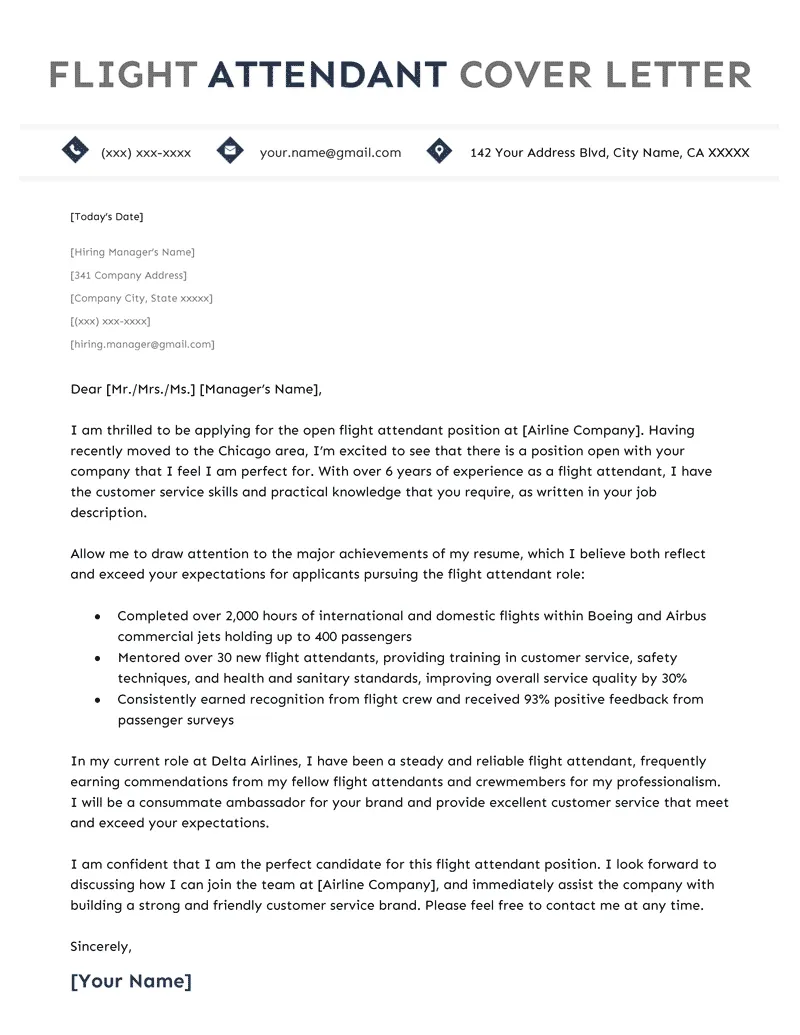
The opening paragraph is your chance to grab attention. Start by stating the position you are applying for and how you heard about it. Briefly mention your most relevant skills or experiences that make you a strong candidate. Instead of a generic statement, express your enthusiasm for the airline and the opportunity. Mentioning why you are drawn to their company will show that you are genuinely interested in working with them. This will set the tone for the rest of your cover letter and encourage the reader to continue. Make sure the opening is concise, engaging, and reflects your passion for the role and the company. The key is to be direct and to showcase your understanding of the role and your eagerness to make an impact.
Highlighting Relevant Skills and Experience
This is where you showcase your qualifications and experience. Focus on the skills most relevant to the flight attendant role. Provide specific examples that demonstrate these skills in action. This is not just a list; it’s a story of how your previous experiences have prepared you for this job. Use the STAR method (Situation, Task, Action, Result) to structure your examples, showing the context, what you did, and the positive outcomes. Quantify your achievements whenever possible. For instance, if you improved customer satisfaction, state by what percentage. By highlighting your skills with concrete examples, you illustrate your value to the airline. It’s a crucial section that shows your capability in practice. The ability to connect your past experiences directly to the job’s requirements is critical to making a positive impression.
Customer Service Experience
Customer service is at the core of the flight attendant role. Highlight any experience you have in dealing with customers, resolving issues, and ensuring satisfaction. Provide examples of how you have handled difficult customers or situations. Detail the steps you took to resolve problems, the impact of your actions, and the positive outcomes. Mention how you ensured that customers felt heard and valued. Emphasize your ability to remain calm and professional under pressure. Showcasing specific customer service experiences illustrates your ability to manage the diverse needs of passengers. It highlights your interpersonal skills and demonstrates that you understand the importance of customer care in the aviation industry. Focus on the impact of your actions.
Communication Skills
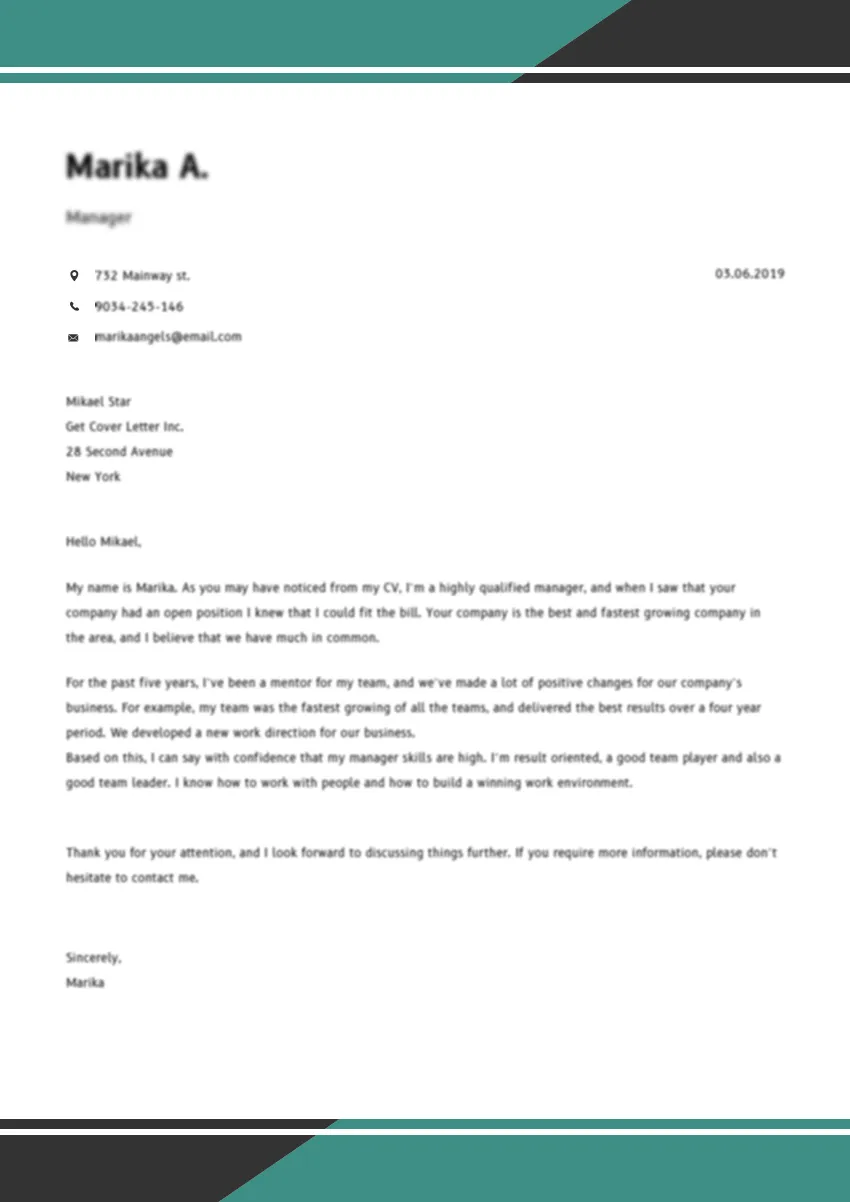
Communication is essential. Highlight both your verbal and written communication abilities. Provide examples of situations where you had to explain complex information clearly and concisely. Mention your ability to adapt your communication style to different audiences. Show that you can listen actively and respond effectively to concerns. Including examples of successful communication in challenging situations highlights your adaptability and ability to interact with diverse personalities. Emphasize your fluency in multiple languages if applicable. Strong communication skills are vital for safety briefings, addressing passenger needs, and coordinating with the flight crew. These skills help foster a positive and secure environment during flights.
Adaptability and Problem-Solving
The ability to adapt to changing situations and solve problems is critical. Provide instances where you demonstrated adaptability and problem-solving skills. Describe how you remained calm under pressure, made quick decisions, and found solutions to unexpected issues. Focus on situations where you needed to think on your feet. Emphasize your ability to manage unforeseen challenges and provide effective solutions. Flight attendants must be prepared for a variety of situations, from medical emergencies to flight delays. Highlighting these skills showcases your ability to handle the unpredictability of the job. Your capacity to remain composed and proactive ensures passenger safety and comfort, which is a crucial aspect of the flight attendant’s role.
Showcasing Your Passion for Aviation
Express your enthusiasm for the aviation industry. Share why you are drawn to flying and working with passengers. Mention any personal experiences or interests in aviation. Demonstrate that you are passionate about providing exceptional service. This will resonate with hiring managers, as passion for the industry is a valuable asset. Your passion makes you more enthusiastic and willing to go the extra mile to ensure a positive experience for passengers. Expressing your commitment shows your genuine interest in the profession. Highlighting your passion for aviation helps to distinguish you from other candidates, showing your commitment to the role.
Expressing Enthusiasm for the Airline

Show that you have researched the airline and understand its values and mission. Mention specific aspects of the airline that appeal to you. This could be its commitment to safety, customer service, or community involvement. Highlighting your understanding of the airline and its culture shows that you are truly interested in joining their team. This shows that you’re a good fit for their company. Customizing your cover letter to demonstrate this research and understanding demonstrates your dedication and interest in the company. Tailor your letter to address the company’s specific values and mission. This will make your application more compelling and memorable.
Demonstrating Cultural Sensitivity
Show that you are aware of cultural differences and can interact respectfully with people from diverse backgrounds. Share examples of your experience with diverse groups. This could include traveling, working with people from different cultures, or volunteering in multicultural environments. Emphasize your openness to learning about and appreciating various cultures. Highlight your ability to create a welcoming environment for all passengers. In flight, passengers come from all walks of life, and showcasing your cultural sensitivity is essential. Demonstrating cultural sensitivity not only shows your understanding of different cultures but also enhances your ability to provide excellent customer service.
Structuring Your Closing Paragraph
In your closing paragraph, reiterate your interest in the position and thank the hiring manager for their time and consideration. Express your enthusiasm for the opportunity and your confidence in your ability to excel in the role. Keep the closing brief, polite, and focused on your desire to contribute. Reiterate your eagerness to discuss your qualifications further and thank the reader once more. Make sure to use a professional closing like ‘Sincerely’ or ‘Best regards’ followed by your full name. The closing should leave the hiring manager with a final positive impression of you.
Call to Action
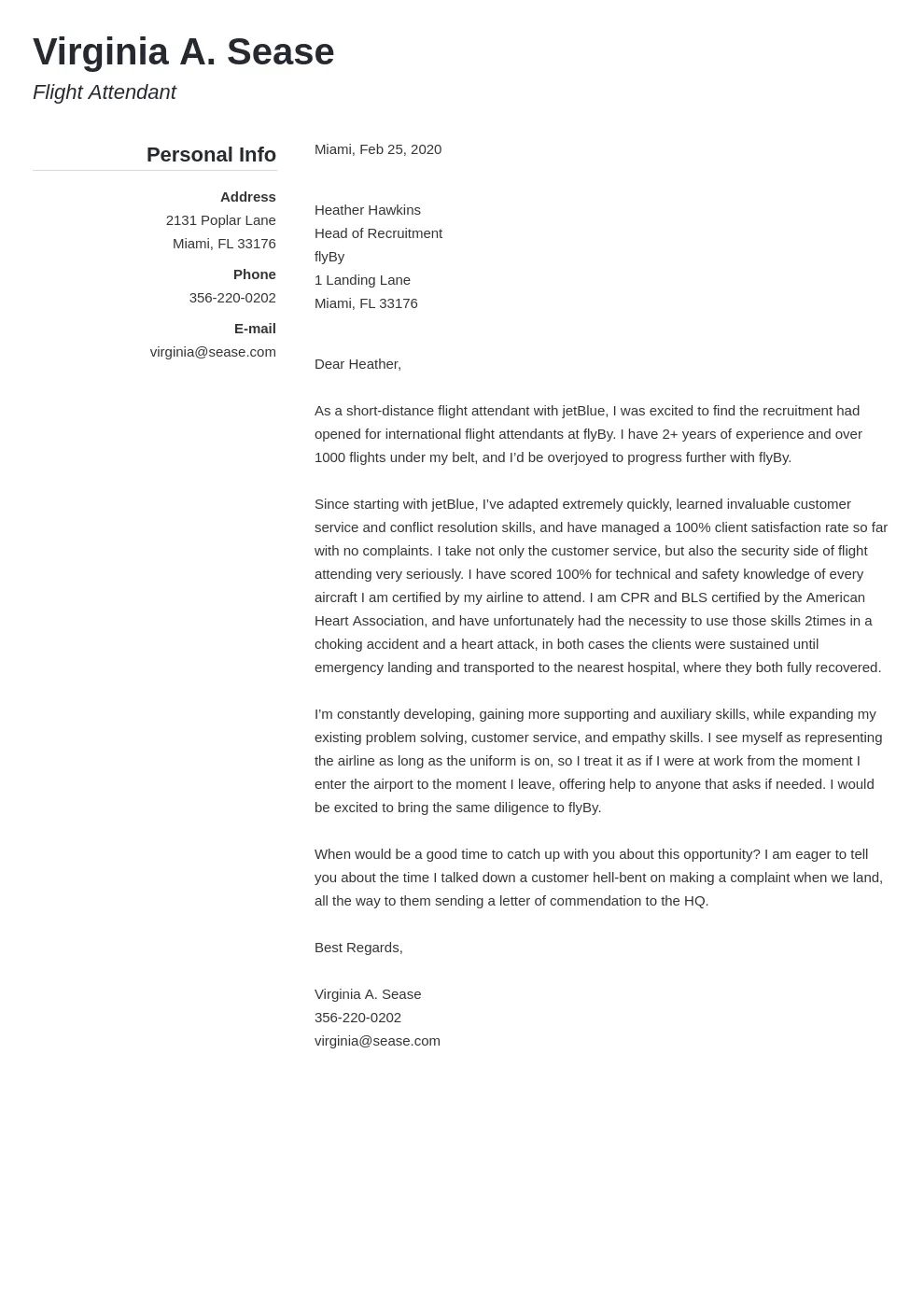
Include a clear call to action in your cover letter. State your availability for an interview and express your willingness to discuss your qualifications. Providing a call to action lets the hiring manager know the next steps, making it easier for them to contact you. Ensure your contact information is prominently displayed and up to date. Make it easy for the hiring manager to respond to your application. A strong call to action clearly indicates your enthusiasm and readiness to move forward in the hiring process.
Formatting and Proofreading
Pay close attention to formatting and proofreading. Ensure your cover letter is easy to read, with clear font choices, adequate spacing, and a professional layout. Check for any grammatical errors, spelling mistakes, or typos. Mistakes can make a negative impression. Always review the document multiple times, or have a friend or colleague review it as well. A polished, well-formatted letter reflects your attention to detail and commitment to excellence. Pay attention to the format: use a professional font, such as Times New Roman or Arial, with a font size of 11 or 12 points. Use clear headings and paragraphs. This helps your cover letter to be well-organized and easy to read, a key factor in your application. Ensure your cover letter is easy to read and error-free, setting a high standard for your application.
Tips for a Strong Cover Letter
Focus on showcasing your relevant skills and experience. Be specific and provide examples to illustrate your abilities. Tailor your cover letter to each job application. Don’t send a generic letter; instead, customize it to reflect the airline’s requirements. Use action verbs to make your writing more dynamic and engaging. Highlight your enthusiasm for the role and the airline. Proofread your cover letter multiple times to ensure it is free of errors. By following these tips, you can create a compelling cover letter that will impress hiring managers and significantly increase your chances of getting an interview. Always remember that a well-crafted cover letter is a key tool in securing your desired flight attendant position.
Tailoring Your Letter to Each Application
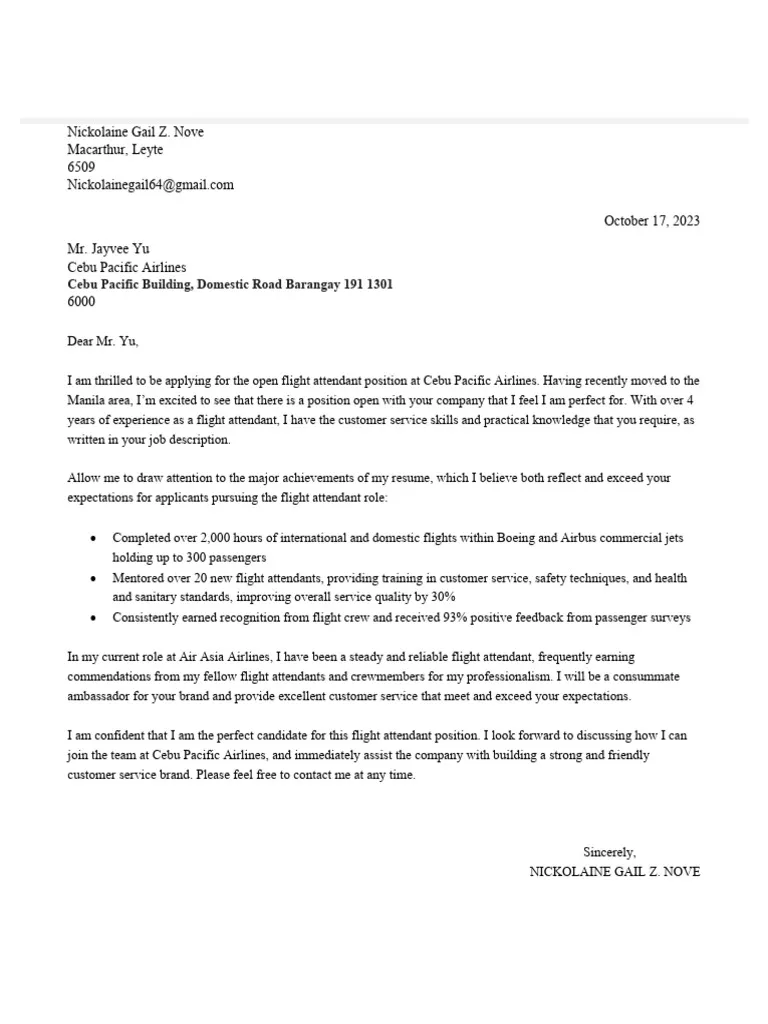
Customize your cover letter for each job application. Avoid sending the same letter to multiple airlines. Research the airline to learn about its values, mission, and the specific requirements of the flight attendant role. Personalize your letter to address the specific needs of the airline. Mentioning the airline’s values and what draws you to their company demonstrates your genuine interest. Tailoring your letter shows that you care about the role and the airline. Customize your cover letter to ensure it is specifically relevant to the job application, showcasing your skills and experiences. This personalized approach demonstrates that you are serious about the opportunity.
Using Action Verbs
Use action verbs to make your writing more dynamic and engaging. Instead of saying ‘I was responsible for,’ use verbs like ‘managed,’ ‘coordinated,’ or ‘implemented.’ Action verbs showcase your achievements and add impact to your descriptions. They highlight your skills in a compelling way. A strong cover letter includes many action verbs to describe your past achievements. This gives the hiring manager a clear picture of your abilities and accomplishments. Utilizing action verbs will help you to grab the recruiter’s attention. Action verbs make your cover letter more engaging and convincing. By using dynamic verbs, you can communicate more efficiently. Verbs such as ‘achieved,’ ‘created,’ and ‘developed’ help showcase your skills and experience in a clear and captivating way.
Proofreading and Editing
Thoroughly proofread and edit your cover letter. Errors can detract from your professionalism. Read the letter multiple times, checking for spelling, grammar, and punctuation mistakes. Consider having a friend or colleague review your letter as well. Even a small error can make a negative impression. A polished, error-free cover letter shows your attention to detail and commitment to excellence. Review the document to ensure it conveys your skills clearly and is free from errors. Proofreading is critical for ensuring your professionalism. Careful editing and proofreading can significantly improve your application and increase your chances of landing your dream job.
Cover Letter Examples to Inspire You
Review examples of flight attendant cover letters to gain inspiration and insight. Look for letters that effectively highlight skills, experience, and passion. Pay attention to the structure, language, and overall tone of the letters. Adapt and tailor these examples to fit your experience and the specific requirements of the airline. While you should not copy, use the examples as a guide to crafting your letter. Reading a variety of examples can offer you fresh insights and ideas. Use these to help you create an effective and persuasive cover letter that will impress hiring managers. Cover letter examples can serve as a great resource, providing helpful writing and formatting tips.
